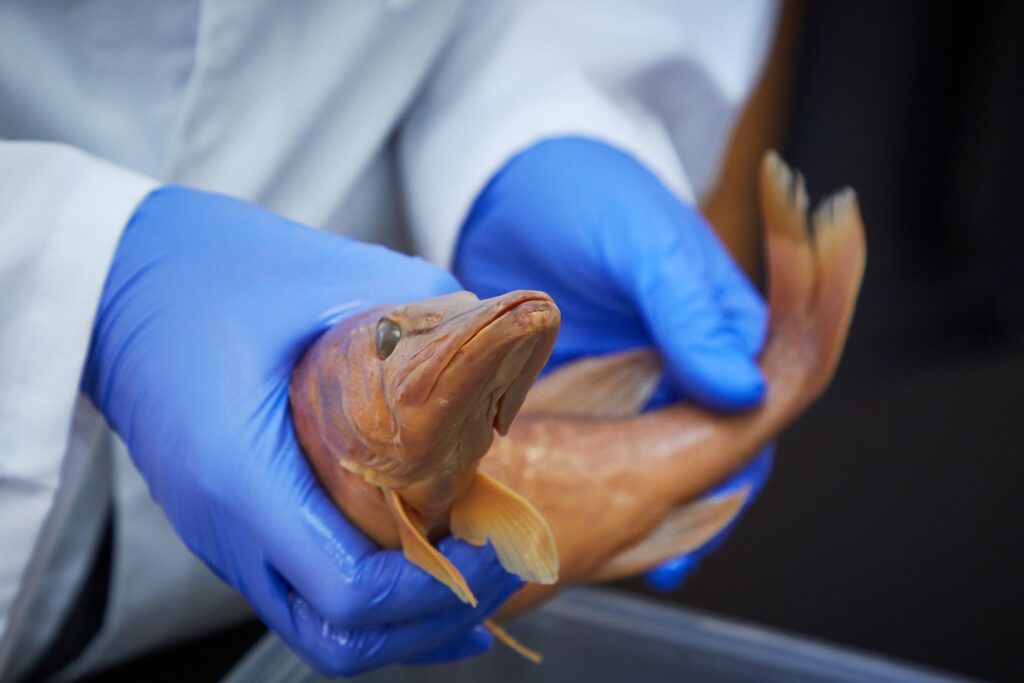Clemson University biologist Samantha Price will study fish and scales as a part of her National Science Foundation Early Faculty Career Development Award, but probably not in the way you’re thinking.
Price, an assistant professor in the Department of Biological Sciences, won’t be researching why some fish have scales and some don’t.
Instead, Price and her student researchers will study body shapes of teleost fish, a large and extremely diverse group of ray-finned fish, to determine whether studies conducted on closely related species at small phylogenetic scales translate to other scales.
The NSF CAREER Award is among the most prestigious in the nation for early-career faculty who have the potential to serve as academic role models in research and education and to lead advances in their field.

Price’s lab works to identify the processes that generate the incredible diversity of life on earth, not just in terms of the number of species but also what they look like — the weird and wonderful forms and patterns that they have evolved. In this five-year, $1.26 million project, Price and her students will collect a vast amount of morphological data on small and large phylogenetic scales and run the same analyses to see if the results are identical, predictable or random.
Like a family tree connects a person and their relatives, the phylogeny reveals relationships between species. Some are very closely related — you and your siblings on your family tree, and dogs and wolves on the phylogenetic tree of life. Some are more distantly related — you and your 10th cousin on your family tree, and dogs and foxes or even dogs and cats on the phylogenetic tree.
“There’s a common ancestor, but you’ve got to go back many generations in terms of your family tree and many millions of years in the case of the phylogeny,” Price said. “I want to know if studies conducted on very closely related species at small phylogenetic scales can provide insights into evolution at larger scales and vice versa.”
Price chose teleost fish, which comprise approximately half of all vertebrate species, because she had data on 6,000 species of teleost fish from a previous NSF grant she could build upon.

“I had the very broad patterns already. We had spent seven months in museums measuring 16,000 specimens, so I had a really good basis to start. Now, I’m going to go and measure all species within certain genera and within certain families to create those smaller scales,” she said.
Price and her students will add measurements and photographs of 17,500 additional specimens from around 4,500 species. The specimens are part of the Smithsonian Institution’s fish collection, one of the largest in the world.
The researchers will measure the length, depth and width of the fishes’ head, body and tail.
“The width is important. Our current work showed that the width is highly variable. That’s one of the main axes which differ in shape. That’s why it’s important to actually go and measure them as well as take the photos,” she said.
The research will help researchers better understand the rules that govern the evolution of biodiversity.
“Although rarely acknowledged, it is currently assumed that the conclusions identified at one scale can be applied to all other scales. However, this critical assumption is yet to be validated,” said Price, a macroevolutionary biologist who usually works at very large scales.
Price continued, “This will have broad implications for synthesizing results across fields that work at different scales and in particular, the ability to connect studies on fossils and living organisms.”

NSF CAREER grants must have an educational component. Price plans to develop new labs that provide undergraduates with hands-on experience doing original research. Over the course of a semester, students would develop projects, collect data from the vertebrate and entomology collections on campus and digitized collections from other museums, and analyze the data to identify patterns within and between species.
“I am so thrilled that Dr. Price received this NSF CAREER award because it provides a foundation for a successful career in research and education. Her research investigating the evolution of biodiversity within vertebrate animals fits perfectly with our department’s mission to integrate across biological scales ‘from molecules to ecosystems,’ and her development of an advanced Classroom-based Undergraduate Research Experience (CURE) lab will be a first for the department,” said Department of Biological Sciences Chair Saara DeWalt.
The College of Science pursues excellence in scientific discovery, learning and engagement that is both locally relevant and globally impactful. The life, physical and mathematical sciences converge to tackle some of tomorrow’s scientific challenges, and our faculty are preparing the next generation of leading scientists. The College of Science offers high-impact transformational experiences such as research, internships and study abroad to help prepare our graduates for top industries, graduate programs and health professions. clemson.edu/science
Get in touch and we will connect you with the author or another expert.
Or email us at news@clemson.edu
